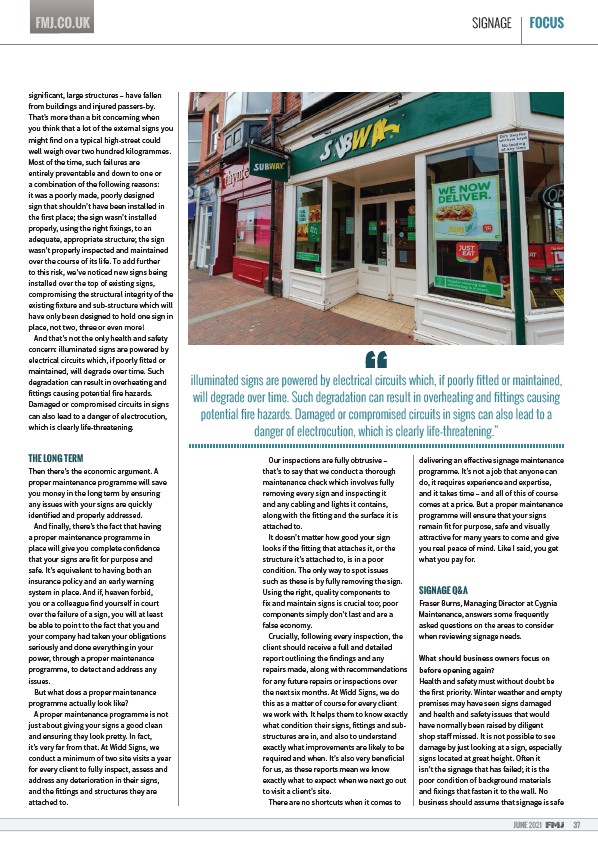
FMJ.CO.UK SIGNAGE FOCUS
illuminated signs are powered by electrical circuits which, if poorly fi tted or maintained,
will degrade oYer time. Such degradation can result in oYerheating and fi ttings causing
potential fi re hazards. Damaged or compromised circuits in signs can also lead to a
JUNE 2021 37
danger of electrocution, which is clearly life-threatening.”
Our inspections are fully obtrusive –
that’s to say that we conduct a thorough
maintenance check which involves fully
removing every sign and inspecting it
and any cabling and lights it contains,
along with the fitting and the surface it is
attached to.
It doesn’t matter how good your sign
looks if the fitting that attaches it, or the
structure it’s attached to, is in a poor
condition. The only way to spot issues
such as these is by fully removing the sign.
Using the right, quality components to
fix and maintain signs is crucial too; poor
components simply don’t last and are a
false economy.
Crucially, following every inspection, the
client should receive a full and detailed
report outlining the findings and any
repairs made, along with recommendations
for any future repairs or inspections over
the next six months. At Widd Signs, we do
this as a matter of course for every client
we work with. It helps them to know exactly
what condition their signs, fittings and substructures
are in, and also to understand
exactly what improvements are likely to be
required and when. It’s also very beneficial
for us, as these reports mean we know
exactly what to expect when we next go out
to visit a client’s site.
There are no shortcuts when it comes to
delivering an eˆ ective signage maintenance
programme. It’s not a job that anyone can
do, it requires experience and expertise,
and it takes time – and all of this of course
comes at a price. But a proper maintenance
programme will ensure that your signs
remain fit for purpose, safe and visually
attractive for many years to come and give
you real peace of mind. Like I said, you get
what you pay for.
SIGNAGE Q&A
Fraser Burns, Managing Director at Cygnia
Maintenance, answers some frequently
asked questions on the areas to consider
when reviewing signage needs.
What should business owners focus on
before opening again?
Health and safety must without doubt be
the first priority. Winter weather and empty
premises may have seen signs damaged
and health and safety issues that would
have normally been raised by diligent
shop staˆ missed. It is not possible to see
damage by just looking at a sign, especially
signs located at great height. O‘ en it
isn’t the signage that has failed; it is the
poor condition of background materials
and fixings that fasten it to the wall. No
business should assume that signage is safe
significant, large structures – have fallen
from buildings and injured passers-by.
That’s more than a bit concerning when
you think that a lot of the external signs you
might find on a typical high-street could
well weigh over two hundred kilogrammes.
Most of the time, such failures are
entirely preventable and down to one or
a combination of the following reasons:
it was a poorly made, poorly designed
sign that shouldn’t have been installed in
the first place; the sign wasn’t installed
properly, using the right fixings, to an
adequate, appropriate structure; the sign
wasn’t properly inspected and maintained
over the course of its life. To add further
to this risk, we’ve noticed new signs being
installed over the top of existing signs,
compromising the structural integrity of the
existing fixture and sub-structure which will
have only been designed to hold one sign in
place, not two, three or even more!
And that’s not the only health and safety
concern: illuminated signs are powered by
electrical circuits which, if poorly fitted or
maintained, will degrade over time. Such
degradation can result in overheating and
fittings causing potential fire hazards.
Damaged or compromised circuits in signs
can also lead to a danger of electrocution,
which is clearly life-threatening.
THE LONG TERM
Then there’s the economic argument. A
proper maintenance programme will save
you money in the long term by ensuring
any issues with your signs are quickly
identified and properly addressed.
And finally, there’s the fact that having
a proper maintenance programme in
place will give you complete confidence
that your signs are fit for purpose and
safe. It’s equivalent to having both an
insurance policy and an early warning
system in place. And if, heaven forbid,
you or a colleague find yourself in court
over the failure of a sign, you will at least
be able to point to the fact that you and
your company had taken your obligations
seriously and done everything in your
power, through a proper maintenance
programme, to detect and address any
issues.
But what does a proper maintenance
programme actually look like?
A proper maintenance programme is not
just about giving your signs a good clean
and ensuring they look pretty. In fact,
it’s very far from that. At Widd Signs, we
conduct a minimum of two site visits a year
for every client to fully inspect, assess and
address any deterioration in their signs,
and the fittings and structures they are
attached to.